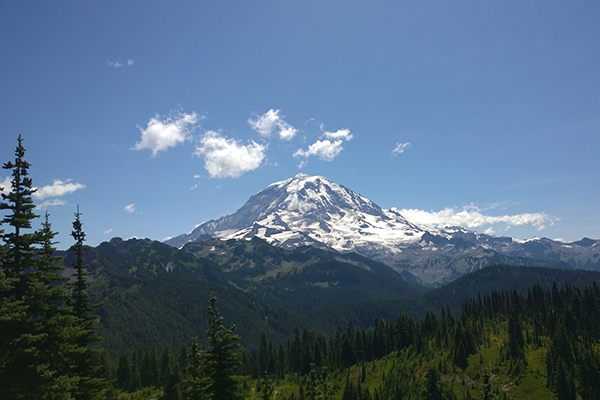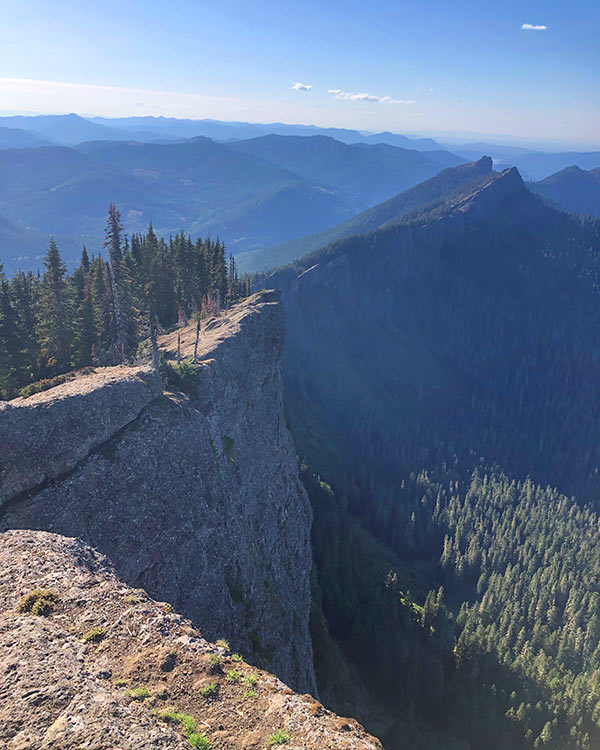Subtotal: $
Checkout
The Wonderland Trail
The only thing that seemed to matter was the wind and the rock and every living thing.
By Morf Morford
October 12, 2024
The Wonderland Trail goes around Mount Rainier at approximately its midpoint. It is ninety-three miles long and traverses glaciers, rivers, crevasses, wetlands and, of course, offers stunning alpine views. Encounters with creatures, forces of nature, and one’s own limitations on the trail leave memories that could easily last a lifetime.
Mount Rainier covers about 370 square miles. It is the source of five major rivers, and has multiple microclimates. Among any other signs of the mountain’s scale, in 1946 a plane with 32 US Marines crashed on the westside of the mountain. The bodies and most of the plane were never recovered.
There are those who race through, and seek to “conquer” the trail in record-setting time.
I have no interest in rushing through such an experience. I’d far rather, as John Muir and Henry David Thoreau both put it, “saunter” through a terrain that, though I see it almost every day in the distance, fascinates me even though it holds little to no regard for human concerns or values. Or even survival.
To “saunter,” after all, means to take the journey slowly, taking the time to notice, appreciate, even cultivate, the unexpected wonders that one encounters in the wild.
From a luscious breeze through a grove of ancient coniferous trees, to a knowing glance from well-camouflaged forest resident, the wilderness holds surprises, and of course occasional (sometimes life-threatening) hazards, that one never encounters on, or near, a suburban sidewalk.
The entire trail usually takes about ten days to cross, with several of those days including elevation gains (and sometimes drops) of five or six thousand feet. These elevation swings, along with the passing of the day and the passing of the season, can bring one into conditions one learns to (at least to some degree) be prepared for.

Mount Rainier. All photographs courtesy of the author.
Even at the height of summer, snow and ice are likely at those altitudes. The year-round snow is stunningly beautiful, but a hot day a melting snow can cause major flooding in the valley below without a drop of rain.
There is nothing like an abrupt alpine thunderstorm, many miles from even the crudest shelter, to remind one of one’s all too fragile mortality.
On one of the first days of my first attempt to complete the entire trail, my companions and I rounded a cliffside path and came upon an alpine ravine. We were just above the tree line, about 8,000 feet above sea level. From that point, looking up, one sees only largely barren rock faces exposed to endless wind, and seemingly endless time. Seasons, years, even decades or centuries, pass over those stones with virtually no visible impact.
And every sound, from the scritch of tiny (or not so tiny) mammals to the sqrack of unearthly looking (and sounding) birds echo from stony faces, through the thin alpine air and again from distant cliffsides.
One realization that leaps out at that altitude is that this mountain is in fact a single massive rock – with its fractured fragments scattered across the surrounding terrain.
In the distance, through stunningly clear in the alpine air, we could see, across the valley, the next peak, six or eight miles away.
The valley itself was a steep drop of several thousand feet.
The valley, at minimum, was wide and deep enough to entirely swallow a good-sized city.
As we took in the immensity of bare and open space, rock, wind and the distant trickle of multiple waterfalls, time itself seemed like the most obtuse abstraction. In fact, confronted by all these facets of “reality” – stone and wind, water – human concerns of time, tradition, or social propriety seemed irrelevant.
As we stared in silent wonder, we noticed a shimmering peripheral movement toward the valley floor. From our height, the movement could have still been a thousand or two feet above the valley floor.

We watched a tiny ink-blot black fleck circle thousands of feet below us.
As we observed this dark creature soar in the late morning sun, we noticed its white head and tail feathers.
Not everyone gets to see a bald eagle in free flight coasting across the air currents only it can read, but to look down on an eagle in flight, is certainly one of nature’s wonders reserved for those who step out on the edge of a dizzying cliff-face.
We were nowhere near a summit, but this was, by any definition, a “mountain top” experience.
In that moment, on that ledge, my human concerns and accomplishments seemed to evaporate like mists on a fall morning.
Cities suddenly seemed frail and vulnerable, money and status seemed absurd and arbitrary, and human lust for power (over what?) just seemed pathetic and embarrassing.
The only thing that seemed to matter was the wind and the rock and every living thing, the sheer shimmering exuberance of existence.
I found myself lost, found, embraced, maybe even absorbed into the being, the now, the forever, the immediate.
I found myself, with my companions, mechanically taking the next step and slipping back into that schedule and hiking pace that seemed so important the day before.
I lost – and found – something immeasurable that day. I still can’t say what it was, but every once in a while I turn some corner, or look at a cloud, or into a child’s eyes and recognize a reflection in the intimate distance that reminds me of a place larger, closer, and more immense than our senses can register.
Already a subscriber? Sign in
Try 3 months of unlimited access. Start your FREE TRIAL today. Cancel anytime.







Randall Toews
I can appreciate the authors experience on Rainier. One of my peak experiences was among scores of orcas while I sat in a small open boat as they passed under me. Feeling awe and “one with nature “ is not just a cliche.